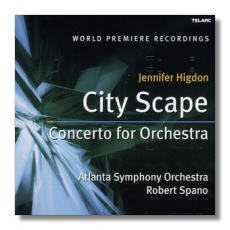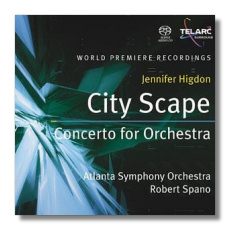
The Internet's Premier Classical Music Source
Related Links
- Higdon Reviews
- Latest Reviews
- More Reviews
-
By Composer
-
Collections
DVD & Blu-ray
Books
Concert Reviews
Articles/Interviews
Software
Audio
Search Amazon
Recommended Links
Site News
 CD Review
CD Review
Jennifer Higdon

première Recordings
- Concerto for Orchestra
- City Scape
Atlanta Symphony Orchestra/Robert Spano
Telarc CD-80620 DDD 66:17
Also released on Hybrid SACD SACD-60620
Amazon
- UK
- Germany
- Canada
- France
- Japan
- ArkivMusic
- CD Universe
This was an eagerly awaited recording for me, after having heard a live performance of the Concerto for Orchestra last September by the Milwaukee Symphony Orchestra under Andreas Delfs, and after the tremendous success of that work in many locations, since its première in Philadelphia on June 12, 2002. Higdon has been enormously successful with performances, commissions and recordings. (I previously reviewed her Blue Cathedral on Telarc 80596). City Scape, Atlanta's first commission under Spano, and premièred there on November 14, 2002, was an added bonus on this release; I had not heard of it prior to the recording, though I knew that the concerto was to be released on disc this year. Like the concerto, it is a major work running over a half hour.
When I heard the live performance of the Concerto for Orchestra, the first movement seemed more than I could take in. Indeed, it begins with a clang, and sets out at a furious pace, and the whole orchestra gets a workout. That is true of the concerto as a whole, also. Each section is featured and there are quite a few solo opportunities. Higdon says she composed the first movement last, and the central movement (of five, like Bartók's Concerto for Orchestra) first. There is considerable variety in dynamics, pacing, instrumentation, and general intensity, particularly in the opening movement. There is some soft playing by the percussion as well as the woodwinds. Rapid scurrying is relieved by some slower, smoother playing by the brass. The movement ends quietly; in fact it dies away.
The second movement is for strings alone, and begins with a very satisfying, lively and extended pizzicato passage. This is followed by a bowed violin solo, with other players than gradually taking up their bows also. Some quiet playing contrasts with intense and contrapuntal passages.
The ten and a half minute central movement is not described, only numbered, like the others, but Bartók might have designated it misterioso. It has short, quiet percussive phrases. The following passage is more reminiscent of Copland, though, with melodic writing for woodwind, strings, and soft brass. Intensity and loudness increases by the middle of the movement, with some sharp attacks by the strings, with drums and syncopated rhythms. Woodwinds, brass and strings play and there is a brief bass solo and violin solo. Some soft quiet playing that struck me as perky and even wispy yields to a major climax with syncopated rhythms that I find thrilling. The ending, like the beginning, is quiet.
Movement IV is for percussion (and harp) and it is a splendid tour de force for that section. Beginning very quietly with what I take to be playing on water glasses, there is then gentle tapping, chiming and rattling, with an Asian tinge to the sound. The last couple of minutes feature some really loud syncopated drumming.
Without pause, the finale begins with strings slashing through the drumming, followed by woodwind trills and a skipping melody. It builds to a furious pace with something like a brass fanfare at one point. Some of the driving rhythms here reminded me of the Stravinsky of Sacre. There is a tremendous amount going on towards the end, which arrives with a thump.
City Scape has three named movements, "Skyline", "river sings a song to trees," and "Peachtree Street." The commission specified that each might be programmed individually. As it happens, the middle movement is by far the most substantive, and longer than the others put together, at 17:39.
"Skyline" is fast and loud, a good curtain raiser. It hurries and scurries, with dancing, thrusting and perky melodic phrases. It also has some gentler moments.
The "river sings a song to trees" section begins and ends very softly, with mysterious, tinkly sounds that can be heard as wind-like. There are murmuring strings and quiet pauses. The flute and lower woodwinds play quietly. Only after four or five minutes does the music become loud, and then there is an intense climax, followed by a return to quiet strings, woodwinds and muted brass. There is a Coplandesque quality here (the Copland of Quiet City, perhaps, but recall that some of that is quite intense). There are some nicely interwoven melodic lines. Rising and falling intensity displays a wide range of instrumentation from soft woodwind to loud drumming against the brass and a shrill flute or piccolo, as well as horn calls. The last couple of minutes in the movement are quiet and peaceful.
"Peachtree Street" is lively and the pace is lively, even headlong, sometimes skipping along. Some of the rhythmic momentum reminded me of Martinů. Again here Higdon allows the whole orchestra to shine.
Nick Jones, in his note to this recording says that "having begun as a flutist, Jennifer Higdon tends to think in terms of melody and color when she composes, rather than thematically. The listener's ear is not drawn to themes and their development, but to bright patches of color, exuberant rhythms, and fascinating shifts of texture." I agree with that; her rhythmic gifts and skills at orchestration are tremendous, and for me this is enough to find her music enormously exciting and satisfying. Accordingly I recommend this disc highly.
The recording, from "Direct Stream Digital" masters is fine. I was tempted to invest an extra $5 in the SACD as a demonstration disc, even though I don't have the equipment to make the most of that; I'm sure that those who have such will want to do that.
Copyright © 2004, R. James Tobin





















